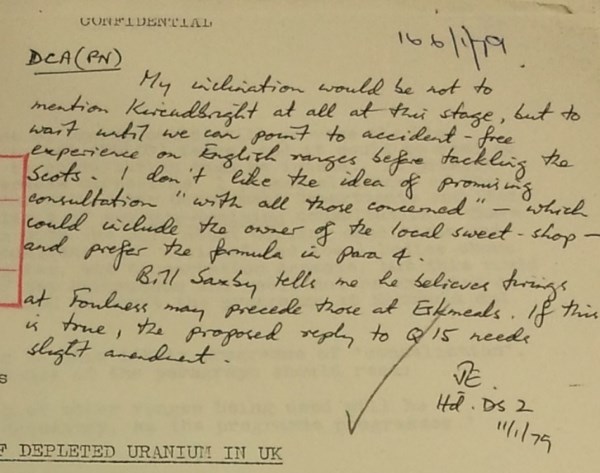
Notations on document from 17 January 1979
Freedom of Information requests and searches of The National Archive provided the evidence that confirmed the firings. The journalist Rob Edwards, in the Sunday Herald 6 November 2011, published a summary of some early government papers, 1973 – 1977, from The National Archive.
These exchanges show there was knowledge about the potential persistent contamination from Depleted Uranium dust. But what emerges also is the manoeuvring by the government and MOD to keep the firings secret from the Scots and the contempt with which the public was held.
A lighter note comes from considerations for re-naming DU, more in line with American efforts, to get away from ‘nuclear’ associations: Penetroy, Staballoy. The background demands of the US Military are evident.
Like the minutes of the DUFERC meetings, these snatches of government thinking provide background for the spoken-word text, a validation of the impunity with which these firings were undertaken.
7/23 February 1973 _ To Director, RSAP, Enfield _ USE OF URANIUM FOR PROJECTILE CORES
- The radiation hazard of the Uranium is likely to be less troublesome than its toxicity and pyrophoricity. The radiation, conveniently detected by meters, enables the spread of particles and dust produced to be monitored and appropriate cleaning operations supervised…
- The butt and surrounding area will be contaminated by the very persistent dust. It will probably be impossible to remove this completely and initial consideration of this fact is essential.
- The existence of these facilities in a remote area (Eskmeals), may enable RSAF to avoid completely the contamination of a part of their range area. It is likely that once contaminated, the area would not be usable for normal firings.
15 March 1977 _ (signature not decipherable – papers marked ‘Secret’)
- Finally, I come to the problem of naming our innocuous penetrator material. The US have chosen Staballoy. I suggest Durametal or Penetroy. Some such name would help us get round the now rather evocative Depleted Uranium in our communications…
6 December 1978 _ From Bruce Millan (Labour) the Scottish Secretary to the Prime Minister (James Callaghan) _ DEPLETED URANIUM AMMUNITION
I have seen the minute of 31 October from Secretary of State for Defence seeking agreement to the storage, development and trials of this ammunition, and suggesting that we should make a public announcement.
I accept that the environmental arguments deployed by the Secretary of State for Defence are very reassuring. Whether they will reassure the public at large, however, is open to some doubt: in Scotland at the moment; the use of the word “uranium” is sufficient to provoke resentment and suspicion. Much publicity is currently being given to anti-nuclear pressure groups and demonstrators who are conducting a campaign against the nuclear power station to be built at Torness in East Lothian. Considerable public attention has also been given to the geological investigation of sites in Scotland to assess their suitability for radio-active waste disposal.
If any initial evaluation firing programme is to be carried out at the Kirkcudbright range, no doubt this will be represented as further evidence that Scotland is being treated as a “nuclear dustbin”. I recognise that for technical reasons the Kirkcudbright range may have to be used, but for the reasons indicated I would want to be consulted about the form and detail of any announcement that is to be made.
18/21 December 1978 _ From Secretary of State for Energy _ To the Prime Minister _ DEPLETED URANIUM AMMUNITION
The development and storage of depleted uranium ammunition in the UK is bound to arouse public interest for the following reasons:
- Because people will not understand what it is;
- Because it can easily be made to appear as a weapon marginally crossing the barrier between conventional and nuclear war;
- Because all matters nuclear are arousing increased public interest especially in terms of side effects.
17 January 1979 _ Paper to multiple government departments on announcing the firings to start in 1980 at Eskmeals _ Handwritten annotation to paper Signed ‘JE’, 11/1/79
My inclination would be not to mention Kirkcudbright at all at this stage, but to wait until we can point to accident-free experience on English ranges before tackling the Scots. I don’t like the idea of promising consultation “with all those concerned” – which could include the owner of the local sweet-shop … Bill Saxby tells me he believes firings at Foulness may precede those at Eskmeals….


